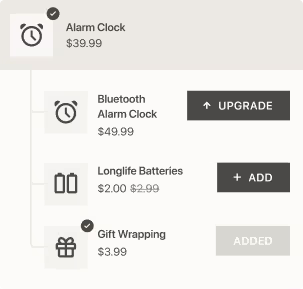We’ve talked about different approaches to customer segmentation in our previous post. This time, we’ll focus on the RFM analysis and explain how it works, why it’s better than other segmentation methods, and how to automate it on Shopify.
What is RFM analysis?
RFM stands for recency, frequency, and monetary value of orders. The RFM model segments customers using these parameters: it evaluates when was the last time a person made a purchase, how often they order, and how much they spend.
Based on this evaluation, each customer is assigned an RFM score. The calculation relies on the range from 1 to 5 for each parameter (recency, frequency, and monetary value) and results in RFM scores from 111 to 555.
How to calculate RFM segments?
The process goes as follows:
- Set the values for each score within each parameter
- Define if some parameters are more important for you than others
- Filter customer order data based on your score values
- Create RFM customer segments
Now some more details.
In the score range, 1 represents the lowest (for example, customers who made a single purchase) and 5 represents the highest (customers who brought the biggest number of orders). While the RFM analysis is a pure calculation, it’s up to you to set particular tiers for each parameter: for frequency, for example, you can assign 5 points to customers with 20, 50, or 100+ orders—the number depends on your particular business.
You can choose how to calculate RFM scores: you can treat each parameter equally or give a bigger weight to one or two of them. If you’re selling long-lasting products, the monetary value will probably be the most significant but if you’re selling something that is renewed on a monthly basis or so, then the frequency will be your major parameter.
When you have the table with all the scores, you can create RFM customer segments. Those who have the highest overall score are your most loyal customers and those on the lowest end are at the highest churn risk.
There can be a different number of groups—you decide what makes sense for your store. With the Loyal app, we went for 6 RFM customer segments distinguishing the most important ones to communicate differently:

The benefits of the RFM segmentation strategy
RFM segmentation is purely based on order history data, which makes it the most objective method. It doesn’t mean that all other methodologies should be rejected: whenever it’s applicable to your business, you can distinguish customer groups based on demographic, geographic, and other characteristics. But with the RFM formula, you’re getting the most universal segments and customer breakdown based on how much trust and loyalty they place in your store.
Speaking of its most significant advantages, RFM customer segmentation is:
- 100% data-driven and accurate. RFM analysis isn’t prone to human error and subjective interpretation. It’s solely reliant on order history data and gives you digestible customer segments based on how they interact with your store.
Plus, it’s always up to date. Unlike other segmentation methods that might be hard to update on time because they rely on different third-party data, the RFM model is always accurate and up to date.
- Helpful in optimizing marketing budgets. RFM data allows merchants to understand which customer groups are worth creating campaigns for and which are better to ignore, saving the resources.
When the RFM analysis was first used back in the 1990s, its primary goal was to optimize marketing costs. Businesses wanted to reduce the expenses of sending direct mail to consumers who won’t be beneficial to them by having more precise estimates of the demand.
- Easily automated. You can perform the RFM analysis in Excel, but there’s no need to go over recency, frequency, and monetary value parameters manually—some tools will do that for you.
You can find different opportunities in services for customer analytics: for example, Panoply offers simple RFM segmentation with SQL queries, and RFM Calc offers an RFM report based on order data exported from Shopify. Also, Shopify apps might be dedicated to or include RFM data.
Shopify RFM segmentation with the help of apps
Check out these apps on Shopify for RFM customer segmentation:
- Loyal (free): the app automatically distinguishes 6 customer groups based on the RFM formula. You can run the analysis as frequently as you’d like to always have fresh reports—regardless of your store’s scale, the app will evaluate your order data in a matter of minutes. Plus, Loyal gives you tips on how to create laser-targeted campaigns for each of the RFM segments. And all that for free!
- RetentionX Analytics (from $179 per month): the app distinguishes 6 customer groups from the top ones to the worst ones. It also integrates with different services to calculate such metrics as customer acquisition cost, average order value, product return rate, and gross margin.
- Reveal: Customer Data Platform (free plan available, from $99 per month for tailor-made RFM segments and other features): the app creates 11 customer groups and gives them fun names (you’ll have “soulmates” as your most loyal customers and “breakup” as a group of lost customers). In the paid plan, you can customize segments and base them on parameters different from RFM: revenue vs. margin, CLV, and others.
- Repeat Customer Insights (from $29 per month): the app identifies 10 customer groups and shows them on different RFM grids, taking only two parameters into account (so it’s the recency frequency model, frequency and monetary value, or monetary value and recency).
Examples of RFM analysis application in marketing campaigns
There’s an endless number of ways to approach different customer segments. Let’s take a look at some of the examples of how you can use RFM segments to better engage with your customers and sell more.
- Effective product launches. When you have a new product release planned, it makes sense to give early access to your most dedicated customers. They’ll appreciate the exclusivity of your offer and can spread the word about your product. If the reaction of loyal customers is good, you can use their reviews when promoting the new product to everyone else.

It can work for both physical and software products. For instance, a company producing the latter can invite long-time subscribers to exclusive beta testing of a new feature. You can nail two birds with one stone: get feedback on your product and make customers feel more involved and therefore more loyal to you.

- Engagement with recent first-time buyers. It’s important to communicate with new customers not to miss the chance to keep them returning to your store. To the group of new recent customers, you can send emails with a discount on the next order, an invitation to the loyalty program, an explanation of relevant products’ benefits, cross-selling offers, etc.

- Retention of customers who haven’t been active. The RFM analysis will show you a group of people you’re at risk of losing. You can re-engage with them by reminding them about your products, new launches, promotions, etc.

RFM segmentation to win more customers over
By definition, RFM segmentation relies on three order characteristics: recency, frequency, and monetary value. The beauty of this method is that it’s centered around precise and accurate data—you can’t go wrong with customer groups created with the RFM analysis. It helps you understand the percentage of loyal customers and those at risk of churn, identify who has the potential to buy more and trust you more, and distinguish those who you can afford to ignore to save marketing dollars.

















